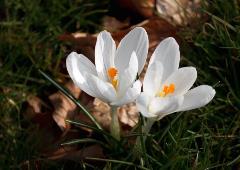
Welcome to the first blog post in our Wildlife-Friendly Gardening series that will show you what to include in your garden to support the surrounding environment in our community and beyond.
Adding native plants into your yard it’s just one of the steps you can take to get you on your way to creating a CWF certified backyard and helping to build a natural, environment. So, this growing season, consider gardening with our wild neighbours in mind!
According to Glen Koblun, manager of Native Plant Solutions with Ducks Unlimited Canada in Winnipeg, incorporating native plants can truly enhance the natural beauty of your yard.
“Mother Nature isn’t streamlined with linear clean edges, but that’s also nice,” he says. “There are a lot of beautiful wildflowers and in fall, the grasses themselves are extremely showy, with purple hues and golden colours.”

The secret, he says, is to understand what was naturally growing in the area when, say, herds of bison roamed the land around Winnipeg.
“You need to understand the mixture of species that survive together and are not in competition,” he explains. “It’s about understanding which species belong where, and that yes, there is going to be an un-manicured look, but I think a lot more people are incorporating this.”
Because there is a common misconception that gardening with native plants can result in a wild, messy, unkempt look it’s important to remember that’s not always in fact the truth.
Incorporating native plants doesn’t mean allowing your yard to be taken over by weeds. It is more about letting it return to its natural state, which not only enhances your property, but also brings greater balance to your yard, neighbourhood and our planet as a whole.
So why choose native plants for your garden?
Native plants require less work.
Choosing native plants for your garden means that there will be a lot less maintenance. When planted in a spot that mimics their natural habitat — in terms of lighting, soil or moisture, they typically thrive with less or no need for fertilizer and watering than other plants.
Native plants are less susceptible to disease and pests.
Having co-evolved with their local environment, native plants have developed defenses that allow them to coexist with other local species, reducing or eliminating the need for pesticides.
Native plants are better suited to meet the needs of local wildlife.
Native plants provide valuable food sources and shelter for the wildlife around them. Many domestic flowers have been bred for showiness and may have lost much of their nectar and pollen-producing capacity.
 Some wildlife species are dependent on the availability of certain native plants.
Some wildlife species are dependent on the availability of certain native plants.
The Karner Blue butterfly, for example, is endangered because of the disappearance of its larval host plant, wild lupine. By choosing plants native to your region you help your local wildlife thrive, let alone survive.
Here are some great plant options to get you started:
- Big Bluestem (Andropogon gerardii) – This is the grass of the Tall Grass Prairie and will grows in almost any soil, from wet clay to dry sand.
- Dotted Blazing Star (Liatris punctate) – Pink in colour, this plant will attract butterflies, hummingbirds, and bees.
- White Prairie Clover (Dalea candida) – A fragrant flower that attracts birds and butterflies because of the seed and necta.
- Purple Coneflower (Echinacea angustifolia) – With health benefiting roots, this flower will attract hummingbirds and is perfect for bees and butterflies.
Looking for more information? There are many more resources available to help Winnipeg families incorporate more native plants into their yards and gardens. One excellent resource is the Winnipeg garden store Prairie Originals, which specializes in native plants. Though many of today’s popular garden plants are imported, native plants are making a comeback for a host of good reasons.
Happy gardening!
Don’t forget to get certified. Use the application form, which provides an excellent roadmap to making your backyard wildlife-friendly and certified through the CWF Backyard Certification program It’s time to make your backyard a welcoming paradise for Manitoba wildlife!